#jewish folklore
Text
Though I’m sure they’re out there I’ve never seen any Jewish people complain about the use of golems in fantasy. In fact, I’ve never seen any Jewish people talk about the use of golems in fantasy at all and I’m curious what your thoughts are on the subject if you’re Jewish.
As someone who has Jewish roots that were completely lost during WWII not because my Jewish family was killed but because they hid their religion and pretended to be Christians even to their own children to keep them safe, going so far as to claim our dark hair and brown eyes were due to a single Spanish ancestor, I’m always deeply fascinated by the use of golems as an allegory for Jewish heritage, but I also thought the use of golems as moving gardens in Dungeon Meshi was unbelievably cute. However, while I relate to gentile characters with lost Jewish heritage I don’t consider myself Jewish and wouldn’t dream of giving my opinion on anything as a Jew, which is why I really want to know what Jewish people who grew up in a Jewish culture feels about the use of golems in fantasy like Minecraft and Dungeon Meshi.

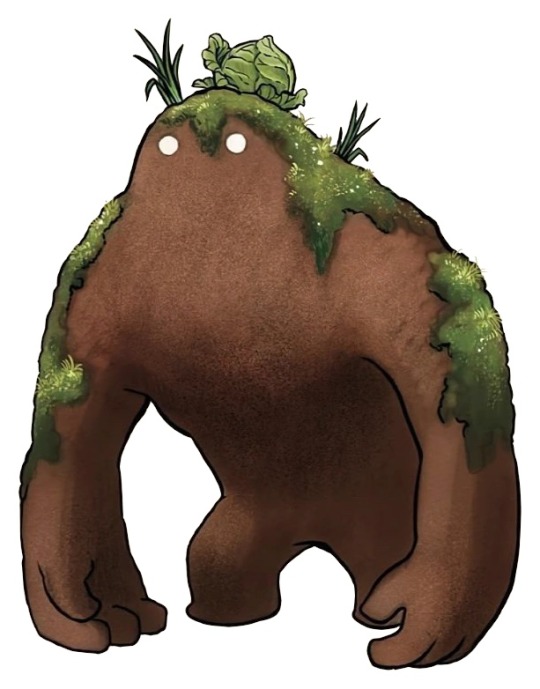

904 notes
·
View notes
Text
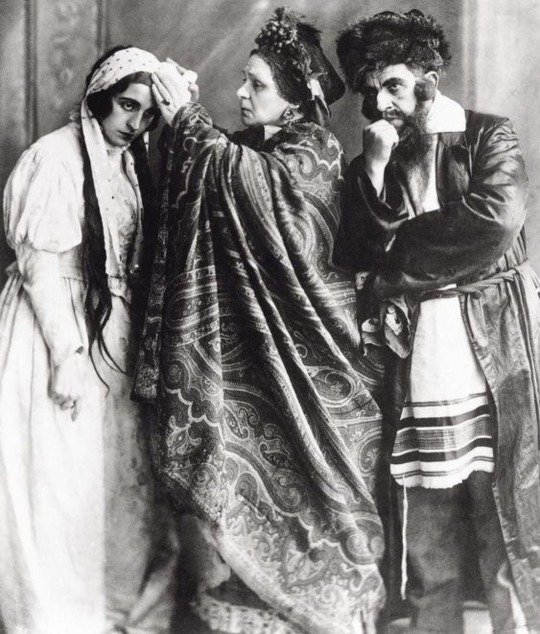
Scene from the most famous Yiddish play The Dybbuk by the Vilner Trupe. 1910s.
#jumblr#jewish#jews#nesyapost#jewish history#jewish culture#yiddish#Poland#Eastern Europe#jewish art#Jewish theater#Jewish actors#the dybbuk#1910s#yiddish folklore#Jewish folklore#ashkenazim#ashkenazi#photography#vintage photography
652 notes
·
View notes
Text
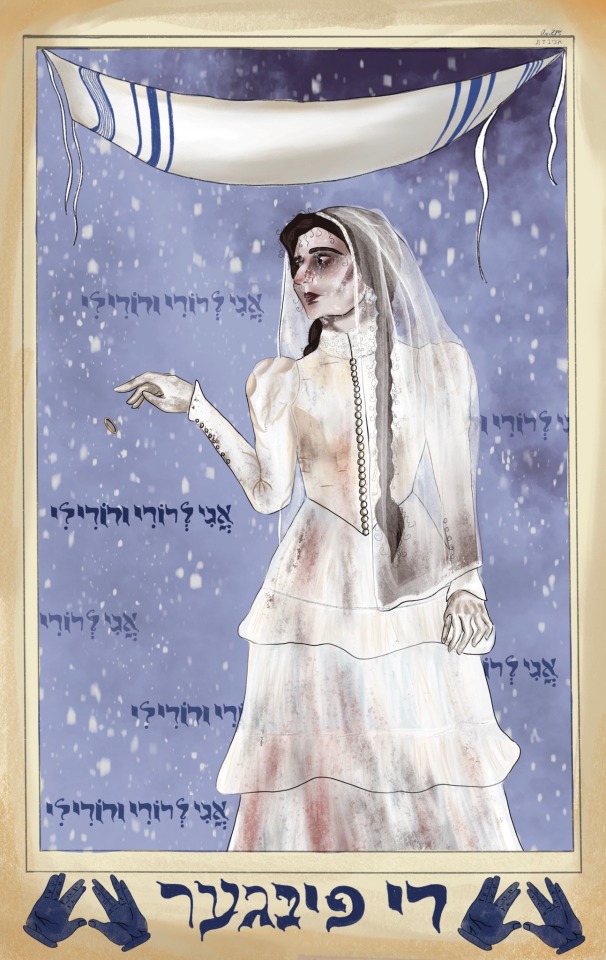
As Halloween approaches, I’ve been seeing many very talented makeup artists recreate the face of the bride in Tim Burton’s “The Corpse Bride.” I thought this would be a good oppertunity to make some art and remind one and all that the “The Corpe Bride” (known in some tellings as “The Finger” or “The Demon in the Tree”) is a beloved Jewish folktale. Folklorist Howard Schwartz traces the orgins of “The Finger” to 16th century Levant. Aftrer hundreds of years of retelling, the story, like all folktales, has undergone many iterations and also became highly informed by the violence of life in the Pale of Settlement (specifically towards women and young brides).
#digital art#art#original art#jewish#jewish art#jewish culture#jewish tradition#jewish things#jewish folklore#jewish folktales#jewish folktale#jewish history#jumblr#folkart#folk art#jewish folk art#jewish folkart#halloween#the corpse bride#der finger#the finger#the demon in the tree#tim burton#tim burton corpse bride#corpse bride#jewish artist
913 notes
·
View notes
Text

Der Golem
974 notes
·
View notes
Text
“I definitely didn’t want to root [Corpse Bride] in a specific place, and wasn’t really interested in what real ethnic origins of the tale were, because the thing that got me was the fable aspect of it”⁹.
Jewish legends are, well, legendary. They are filled with mystery, magic, fascinating creatures, wild adventures, and dazzling heroes. But if you ask most people, even most Jews, they may be largely unfamiliar with Jewish folktales outside of the Bible or Fiddler on the Roof. That is until you unravel the way in which Jewish folklore has been commodified and removed from its Jewish roots in order to be suitable for a non-Jewish audience.
This phenomenon is not new and not singular to Jews–not in the slightest. Cultural stories, and so much more, are routinely co-opted and commodified, erasing the culture, religion, and heritage of the original storytellers in order to make the story palatable for audiences outside of the original group. Sometimes so egregiously or viciously that it is largely unrecognizable to those who aren’t intimately familiar enough to spot it.
One such story is, allegedly, The Corpse Bride.
However, Tim Burton would convince you that the story he heard of (allegedly from within Lilith’s Cave) isn’t actually Jewish–in fact, he doesn't even know the origin. In their 2018 YouTube video, Jewish Erasure in Tim Burton Films, channel The Princess and the Scrivener plays a clip of Burton stating, “Joe had heard a little story, like a paragraph, which was an excerpt from an old fable–I don’t even know from what country it came, my recollection is that it didn’t have a specific place of origin. [I] Wasn't really interested in what the real ethnic origins of the tale were, because the thing that got me was the fable aspect of it”⁹.
READ MORE
2K notes
·
View notes
Photo

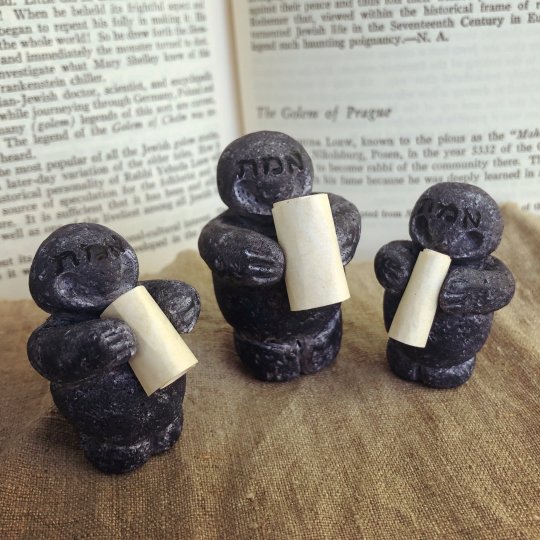
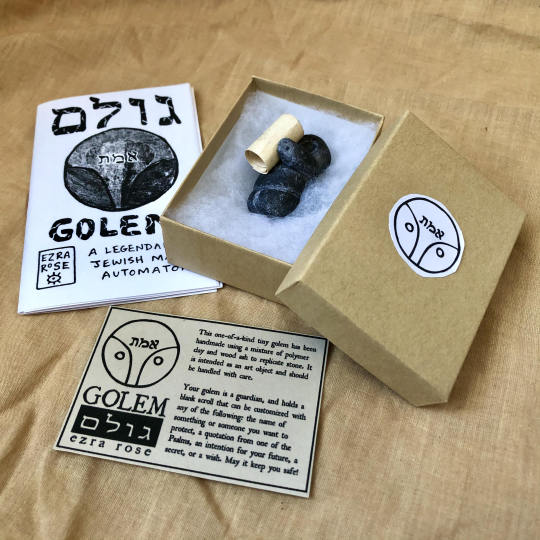
Pocket Golems, 2019 - present
each golem is a one-of-a-kind, hand-sculpted figurine based on the Jewish legend of the golem (גולם), a mythic monster made of clay or stone and given life in order to act as a protector. ranging in size from approximately 1-2" tall, these golems (the Hebrew plural is "glamim") are made of polymer clay mixed with wood ash to replicate stone. they were created to be portable, personal guardians: a reminder of our connections to the mystical side of Judaism and to the stories of our past, or a symbol of Jewish resilience and resistance in a difficult present. each golem holds a blank scroll that can be customized by the owner with any of the following: the name of something or someone you want to protect, a quotation from scripture, an intention for your future, a secret, or a wish.
Etsy
#golem#jumblr#jewish art#jewish folklore#jewish artists#pocket golems#sculpture#will be selling these again at an upcoming local market#whatever doesn't sell will go up in the etsy shop!#i did them by waitlist only for about a year & that was a little much to keep doing#now they're just a special once in a while thing
2K notes
·
View notes
Text
Hey Jumblr, what’s your favorite Jewish story?
could be real or fiction, could be about Jews or just by a Jewish author/creator, could be from the Bible, from the Talmud, from folklore, from wherever, just reblog with your favorite Jewish story whatever it is
I’ll go first: I really love the X-Men, especially the arc of Magneto & Xavier’s relationship, and the story of the golem (I couldn’t pick just one lol)
#runners up were Wolfenstein II: New Colossus Gravity Falls & A Series of Unfortunate Events#jewish#jumblr#jewish folklore#jewish fiction#jewish history#judaism#jewblr#jewish stories
72 notes
·
View notes
Text
I keep having an idea for like a Jewish Percy Jackson book series. Basically the idea that Yiddish/Ashkenazi folklore is/was real and like Percy Jackson's greek gods the dybbuks, Golems, demons and all the rest came west to New York City and they're under the city in the subway tunnels and sewers
And I was thinking of two main characters. There's Josh a very modern teenager, who loves ghost hunters, and super natural podcasts and loves his bubbie's stories of Yiddish folklore. He travels into the subway armed with a camera and ghost hunting equipment and comes face to face with....
Yehudah, AKA Hoodie, a young Hassid from Brooklyn. Hoodie's family from hundreds of years have kept the spirts down, fought monsters, and protected the community, first in the old country and now in New York using folk magic and things
Josh is all about science and trying to understand "okay but how does it work?" and Hoodie is very "it's tradition this how its done, please shut up and stop getting in trouble!" A story of two Bar Mitzvah boys studying Torah, dealing with middle school, each other, and being stuck in the tunnels under NYC in the middle of the night facing the horrors
532 notes
·
View notes
Text
AVE NOX & BEYOND THE PALE
Two HUGE kickstarters that I am really excited about today! I've gotten to watch their development from early on and I can say that I've not been more excited for any TTRPG books for quite a long time!

Ave Nox, a system neutral megadungeon of Forgotten history and disaster deep in the dark of the Earth!
https://www.kickstarter.com/projects/appalachia-gothic/ave-nox by @feralindiecharlie

Beyond the Pale, a horror Osr adventure, inspired by Jewish folklore and mysticism!
https://www.kickstarter.com/projects/lost-pages/beyond-the-pale-a-folktale-adventure by Yochai Gal, @sheydgarden, Shari Ross, Eli Seitz and Paolo Greco as well as an extensive team
#ttrpg community#ttrpg#indie ttrpg#roleplaying games#ttrpg design#ttrpg art#ttrpg stuff#megadungeon#dnd#osr#dungeons and dragons#adventure#jewish folklore#illustration#character design#jewish art#jumblr#beyond the pale#yochai gal
106 notes
·
View notes
Text
Jewish SF/F books for Jewish Heritage Month

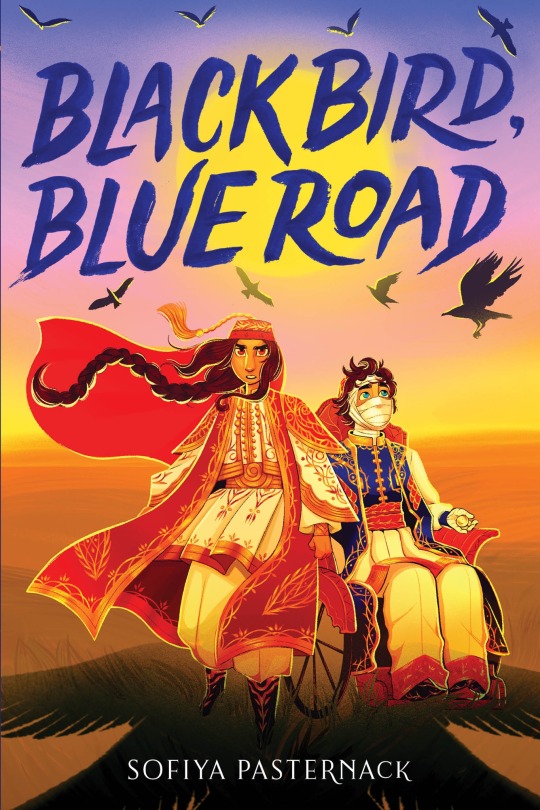


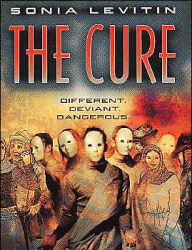
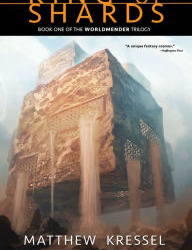


I highly recommend you check out these novels! This is just the tip of the iceberg.
#jewish#fantasy#judaism#books#novels#sci fi#jewish heritage#jewish american heritage month#sff books#jewish folklore#jewish books#jewish mythology#jewish fiction#the arcadia ledger
214 notes
·
View notes
Text
youtube
53 notes
·
View notes
Text
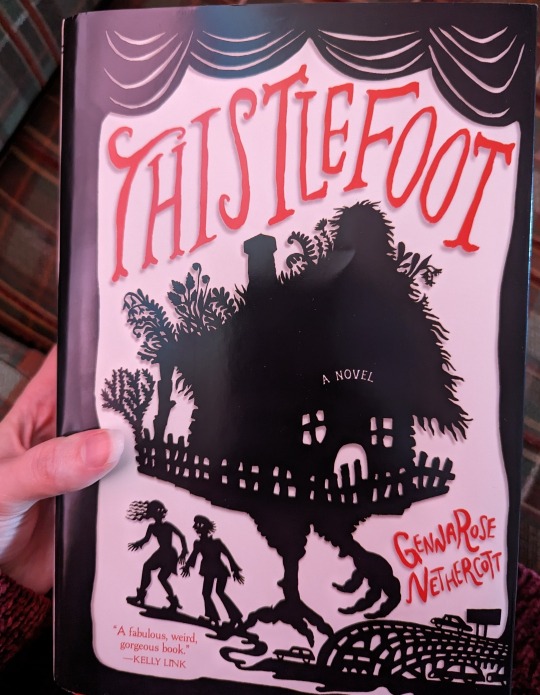
If you're looking to take a breather from real life but still keep it celebrating Jewish culture, I came across this book released last year, "Thistlefoot" by GennaRose Nethercott.
An enchanted adventure illuminated by Jewish myth and adorned with lyrical prose as tantalizing and sweet as briar berries, Thistlefoot is a sweeping epic rich in Eastern European folklore: a powerful and poignant exploration of healing from multi-generational trauma told by a bold new talent.
The Yaga siblings—Bellatine, a young woodworker, and Isaac, a wayfaring street performer and con artist—have been estranged since childhood, separated both by resentment and by wide miles of American highway. But when they learn that they are to receive an inheritance, the siblings agree to meet—only to discover that their bequest isn’t land or money, but something far stranger: a sentient house on chicken legs.
Thistlefoot, as the house is called, has arrived from the Yagas’ ancestral home outside Kyiv—but not alone. A sinister figure known only as the Longshadow Man has tracked it to American shores, bearing with him violent secrets from the past: fiery memories that have hidden in Isaac and Bellatine’s blood for generations. As the Yaga siblings embark with Thistlefoot on a final cross-country tour of their family’s traveling theater show, the Longshadow Man follows in relentless pursuit, seeding destruction in his wake. Ultimately, time, magic, and legacy must collide—erupting in a powerful conflagration to determine who gets to remember the past and craft a new future.
#jumblr#jewish#jews#judaism#nesyapost#jewish culture#jewish history#jewish reading#jewish folklore#book recommendation#slavic folklore#reading list#jewish books#books#thistlefoot#feel bad i haven't made a new post in 10 days but everything has been tense#i haven't been reading anything
88 notes
·
View notes
Note
Do Jewish people have their own fairy tales? Have they ever been published in books?
We absolutely do!
I wouldn't call them fairy tales, though, we call them Midrash, Aggadah, Chassidishe Meises, and folk tales, among many other names. They range from fairytale-like stories with fantastical creatures such as the Ziz, demons, vampires, ghosts, angels, and Golems, to stories about Jewish miracle-workers such as Shlomo HaMelech, Choni Ha'Meagel, and the Baal Shem Tov, to name a few. These stories range from historical accounts to parables to dreams, and they're all extremely important in Judaism and Jewish culture.
Every diasporic Jewish group has their own folktales, and we all have shared folktales regarding the Tanakhic era, and a lot of the Talmudical era.
Storytelling is very important in our culture, and every story is supposed to have a lesson within it. There's a concept in Judaism called "Ma'ase Avot Siman L'Banim", which translates to "A tale of the forefathers is a sign for the children". This means that every story that's was passed down and remembered and recorded was recorded for a reason, to be a lesson for the descendents who learn from it in the future. That's why seemingly inconsequensial happenings are recorded in the Tanakh, because they were recorded for a reason. We may not know the reason yet, but we can reinterpret and derive meaning from all our stories.
Publishing books and written text is extremely important in Judaism, and all these stories have been published multiple times over centuries, sometimes even millenia, in many different version and iterations. I couldn't even begin to try and list all of them, but I encourage you to browse through the links I've included for a good picture of the diversity and beauty of Jewish folk tales.
887 notes
·
View notes
Text
The golem is love the golem is a victim the golem is our duty to fight back the golem is our fear that defending one's self will be seen as violent the golem is a protector the golem is a warning the golem is a blessing the golem is a hero the golem is fear the golem is family the golem is love
1K notes
·
View notes
Note
What would your ideal live action cast be for Corpse Bride?
I've think said this before, but I absolutely hate live action remakes. I feel like they're lazy, soulless cash grabs and almost never good. Ideally, I'd like them to leave Corpse Bride alone ... but if they have to remake it, I think this would be an acceptable cast:
Emmy Rossum as Emily

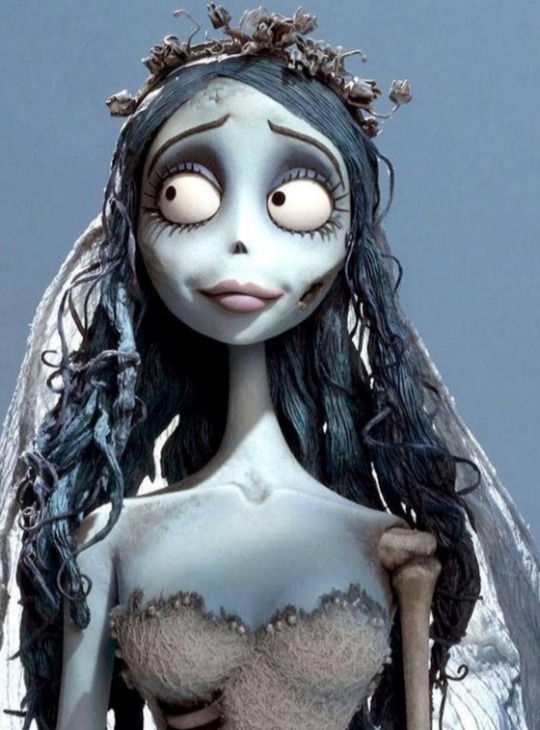
Tom Hiddleston as Victor

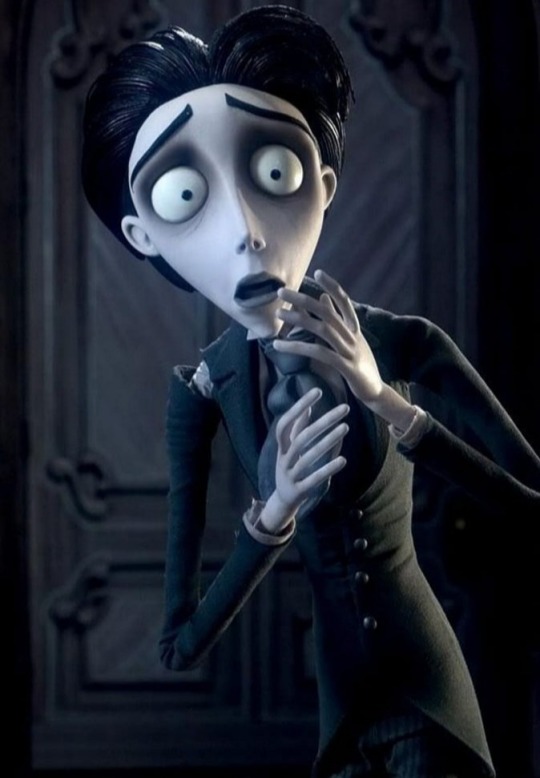
Anya Taylor-Joy as Victoria


Terence Stamp as Galswells


Jack Davenport as Barkis

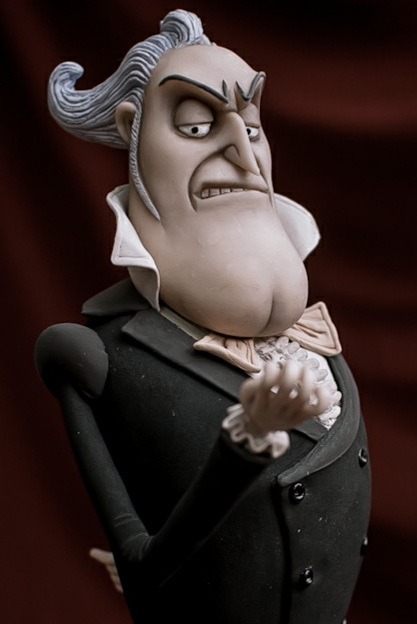
The rest of the characters don't really matter because they would likely be rendered in CGI, in which case they could conceivably have the cast from the stop motion film reprise their roles. They could even have Johnny Depp, Helena Bonham Carter, Emily Watson, and Richard E. Grant voice a few additional lines to pay homage to the original, or they could make live cameos.
Also, if anyone's interested, the story of The Corpse Bride is actually based on a Jewish folklore horror tale called "The Finger". It's not a long read and, if you can believe it, it's even more depressing than the movie, at least from the bride's perspective. I'm not Jewish so I can't be sure if my interpretation is correct, but I came away with the sense that the story is a lesson in ethics, meant to teach children to be careful with their words and not say things they don't mean, as there might be horrible consequences and they could unintentionally hurt someone. I would highly recommend anyone who has an appreciation for the film to check it out!
#corpse bride#tim burton#emily the corpse bride#victor van dort#victoria everglot#emmy rossum#terence stamp#barkis bittern#jack davenport#jewish folklore#the finger#tom hiddleston
58 notes
·
View notes
Photo


Shamir Worm, 2021.
the shamir worm is one of Jewish folklore's "miracles of creation," made at twilight on the sixth day (along with things like the rainbow and Moses' staff): a tiny creature that could cut stone - either by its piercing gaze or with its mouth - it was used by King Solomon to build the first temple, due to the fact that no iron tools or other potential instruments of bloodshed could be used to build a holy monument to peace. some say it was also used to engrave the tablets with the 10 commandments, and to engrave the names of the 12 tribes of Israel on the stones in the priestly breastplate. the mystical shamir is a symbol of creative destruction and a reminder that powerful things can come in tiny forms.
prints available here
682 notes
·
View notes